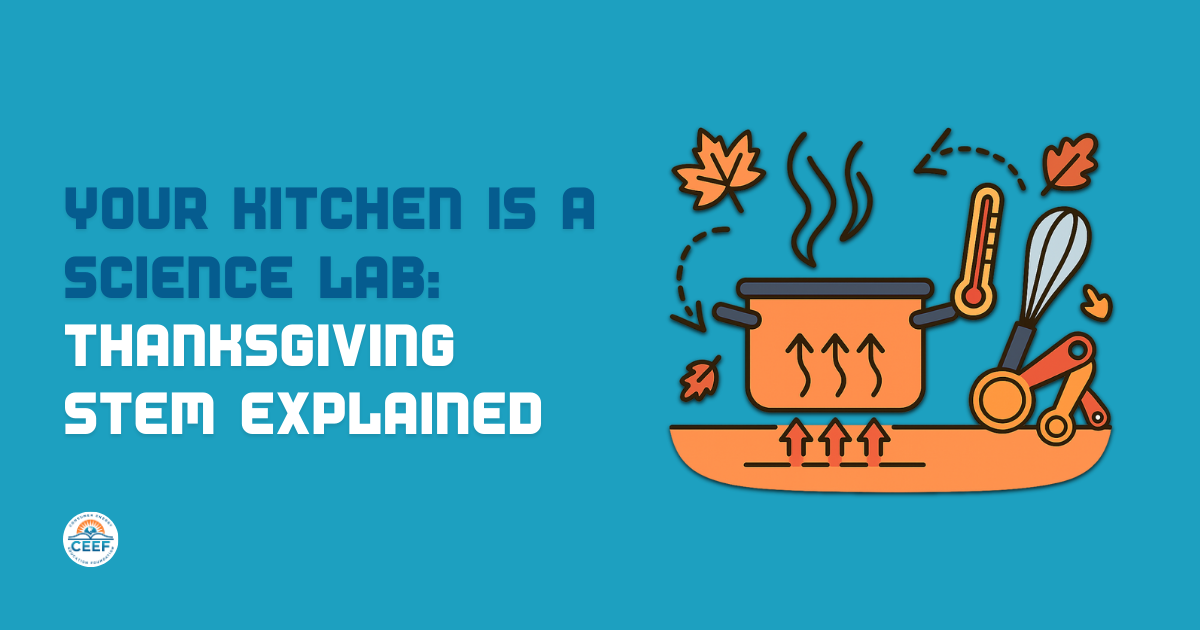
The kitchen might just be the busiest room in America on Thanksgiving Day. Pots are bubbling, the oven timer keeps beeping, and someone is always asking when the rolls will be ready. But beneath all that holiday chaos, something fascinating is happening. Your kitchen has quietly transformed into a science lab powered by energy, chemistry, and a dash of family teamwork.
Before you carve the turkey, let’s peek behind the kitchen door to see how science helps make your favorite holiday dishes possible.
The Power of Heat: Energy in Action
At its core, cooking is all about energy—specifically, how heat moves. Scientists call this heat transfer, and it happens in three ways: conduction, convection, and radiation.
When you slide a baking sheet of cookies into the oven, conduction is the heat that travels from the hot metal pan into the dough, passing energy atom by atom like a game of hot potato.
Convection is the warm air swirling through your oven, helping food cook evenly. If you’ve ever opened the oven and felt a rush of heat, that’s convection at work. And then there’s radiation—no, not the sci-fi kind, but the invisible heat waves from the oven walls that help your turkey turn perfectly golden brown.
Whether it’s mashed potatoes, stuffing, or pie, every holiday dish depends on heat energy traveling exactly where it needs to go.
Cooking Smart, Not Just Hard
Thanksgiving is famous for crowded stovetops and full ovens. But smart cooks—and smart scientists—know that efficiency matters. Each appliance in your kitchen uses energy differently. Ovens require more power to heat a large space, while tools like toaster ovens, microwaves, and slow cookers use far less.
Here’s the science secret: a little strategy can save a lot of energy.
• Preheat only when necessary. If something bakes for an hour, you don’t need your oven warming up for half that time.
• Keep the oven closed. Every peek lets heat escape, forcing your oven to work harder.
• Match your pan to your burner. A small pan on a big burner wastes heat; a good fit transfers energy efficiently.
So when Grandma jokes about “not wasting heat,” she’s actually giving an energy lesson worthy of a science fair ribbon.
The Chemistry of Comfort Food
Cooking isn’t just about heat—it’s about transformation. Every time you stir gravy or watch a pie crust turn golden, you’re watching chemistry in action.
Consider the turkey. As it roasts, its proteins unwind and rebond in new ways, creating that delicious browned crust. This is the Maillard reaction—the same scientific magic that toasts your bread or caramelizes marshmallows.
Gravy thickening? That’s starch molecules swelling and trapping water as they heat.
Flaky pie crust? Butter melts between layers of dough, releasing steam that puffs the crust into delicate layers.
In other words, chemistry is the secret ingredient that makes Thanksgiving taste like Thanksgiving.
Try This at Home: Three Mini Kitchen Experiments
Cooking is full of learning moments. Here are three easy, family-friendly experiments to try before or after the big meal:
- The Thermal Detective
Touch the handle of a wooden spoon and a metal spoon after stirring something warm. Which one heats up faster? Metal conducts heat more quickly—that’s conduction you can feel. - The Energy Saver
Guess which takes more energy: baking four rolls in the oven or warming them in a toaster oven? (Hint: the oven heats a lot of unused space.) Look up energy use for different appliances and compare. - The Heat Wave Test
With adult supervision, hold a paper spiral above a candle or lamp. Watch it spin as warm air rises. That’s convection—the same principle that helps your turkey cook evenly.
A Side of Gratitude (and Science)
When you sit down to your Thanksgiving table, surrounded by family, friends, and a mountain of mashed potatoes, take a moment to appreciate the science that brought it all together. From the energy powering your oven to the chemistry in your pie crust, Thanksgiving is a masterclass in STEM happening right at home.
Curiosity is the secret sauce of the holiday. Ask questions. Try experiments. Wonder out loud. Because when families learn together, science becomes more than a subject—it becomes part of the story.
